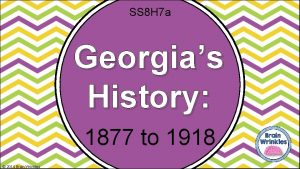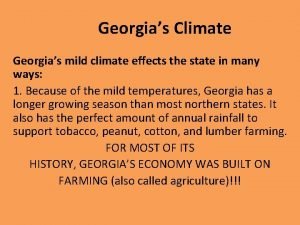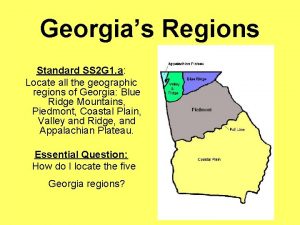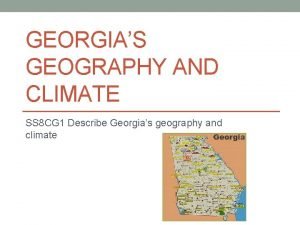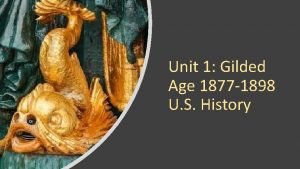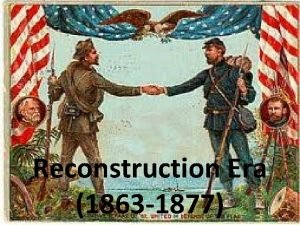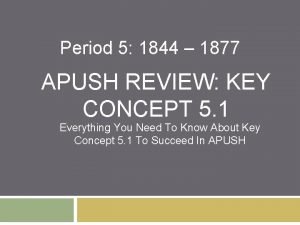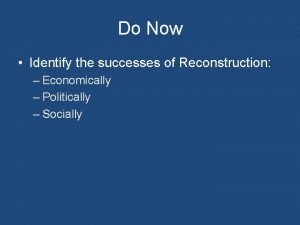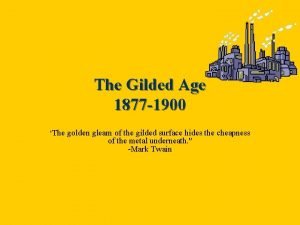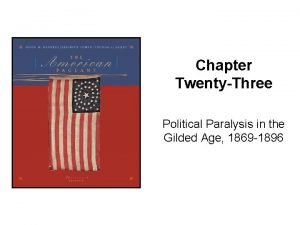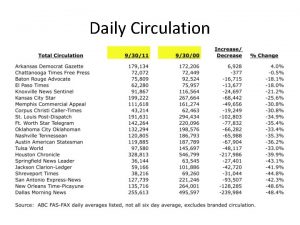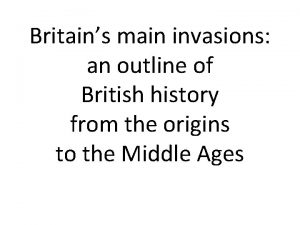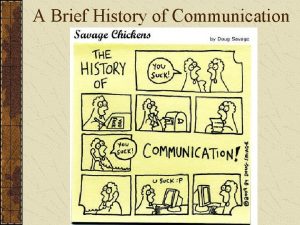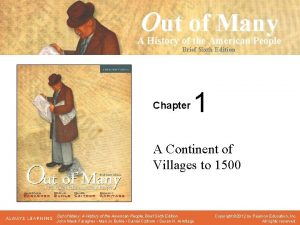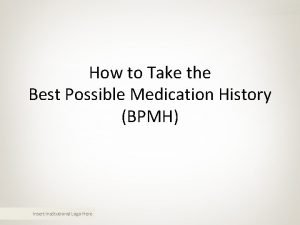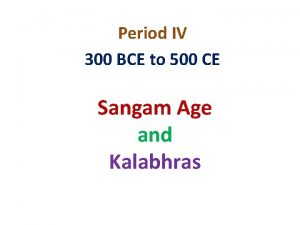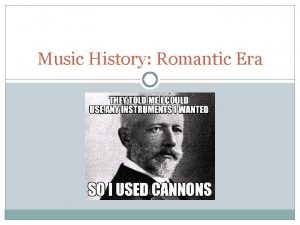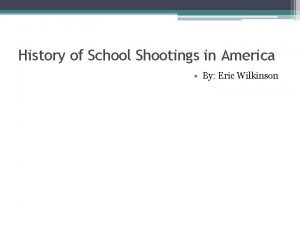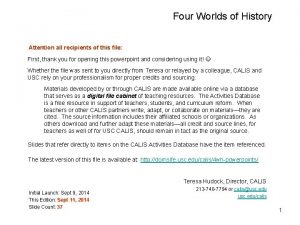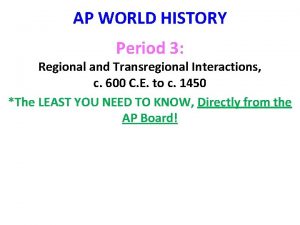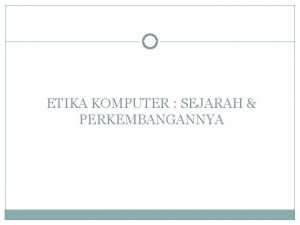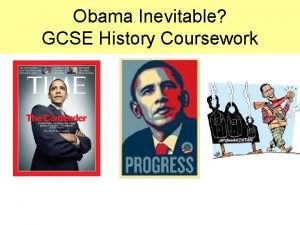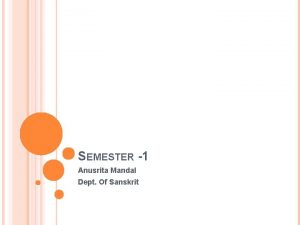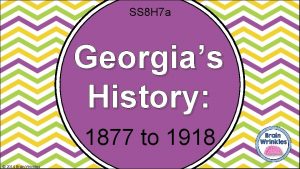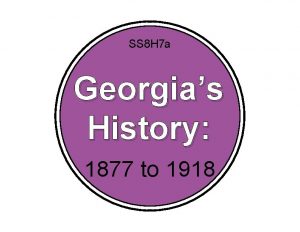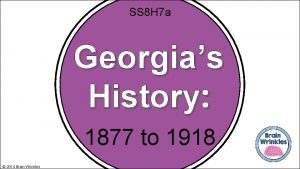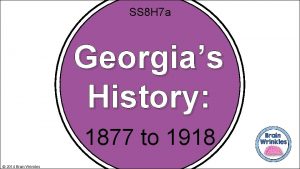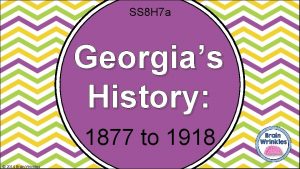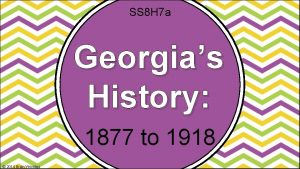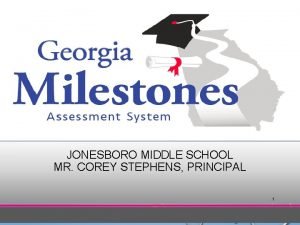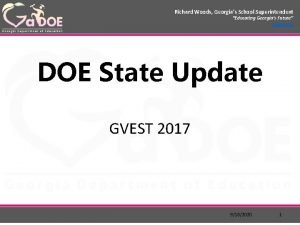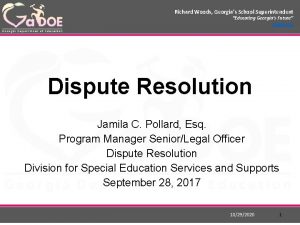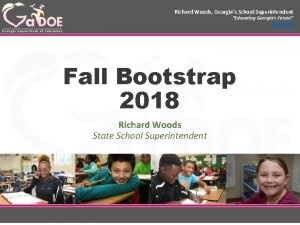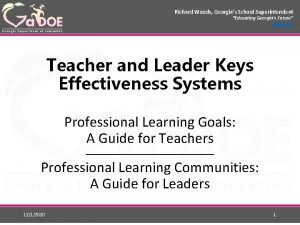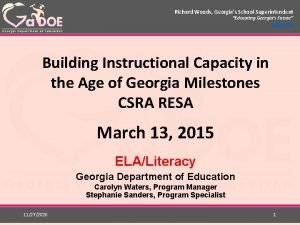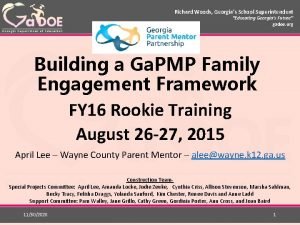SS 8 H 7 a Georgias History 1877




















































- Slides: 52

SS 8 H 7 a Georgia’s History: 1877 to 1918 © 2014 Brain Wrinkles

Standards SS 8 H 7 The student will evaluate key political, social, and economic changes that occurred in Georgia between 1877 and 1918. a. Evaluate the impact the Bourbon Triumvirate, Henry Grady, International Cotton Exposition, Tom Watson and the Populists, Rebecca Latimer Felton, the 1906 Atlanta Riot, the Leo Frank Case, and the county unit system had on Georgia during this period. © 2014 Brain Wrinkles

Teacher Info – Who’s & What’s • Print off the Who’s & What’s handout for each student. (Print front and back to save paper. ) • BEFORE the lesson, have students fill in the squares with what they think each term means. • AFTER the presentation, the students will write down new (factual) information about each term. • Check the answers as a class. © 2014 Brain Wrinkles

Who’s & What’s Directions: BEFORE the lesson, write what you think each term means. AFTER the presentation, you will write down new information about each term. Who I think this is: Henry Grady What I think this means: Definition: Bourbon Triumvirate Definition: Who I think this is: Tom Watson & Populists What I think this means: Definition: International Cotton Expo Definition: What I think happened: 1906 Atlanta Riot Who I think this is: Definition: Rebecca Latimer Felton Definition: © 2014 Brain Wrinkles

Who’s & What’s Directions: BEFORE the lesson, write what you think each term means. AFTER the presentation, you will write down new information about each term. What I think this means: County Unit System What I think happened: Definition: Leo Frank Case Definition: © 2014 Brain Wrinkles

Teacher Directions – CLOZE Notes • The next pages are handouts for the students to use for notetaking during the presentation. (Print front to back to save paper and ink. ) • Check the answers as a class after the presentation. • *Please note – the slides in this presentation are content-heavy. Feel free to open the editable file if you’d like to delete anything. I’ve found that it’s better to have too much than not enough! © 2014 Brain Wrinkles

1877 to 1918 - CLOZE Notes 1 Bourbon Triumvirate • After Reconstruction, _______________________________ rose to power in the South. • Bourbons believed that the South should rely ______________ and more on industry. • In Georgia, three Bourbon leaders _________________________________ from 1872 to 1890: Joseph E. Brown, John B. Gordon, and Alfred H. Colquitt. • The ______________ supported policies that replaced Georgia’s former large plantation-owning class with a new middle and business class. • They also expanded railroads and increased industrialization, ___________________________________ in Georgia. • They promoted “______________ ” in order to keep the political support of white racists. Joseph E. Brown • Joseph Brown was a ______________ who was Georgia’s governor during the Civil War. • He served four terms as the state’s governor until he was named ______________ of the Georgia Supreme Court. • Brown eventually served Georgia as a ______________ from 1880 -1891. • He became one of the state’s ______________. John B. Gordon • John B. Gordon was a Civil War general who later became the __________________________ in Georgia. • He became a ______________ in 1872 and resigned in 1880. • In 1886, Gordon became ______________ for two terms. • He returned to the Senate for one more term before ______________. Alfred H. Colquitt • Alfred H. Colquitt was educated at ______________. • He owned slaves before the Civil War and served in the ______________. • Colquitt was a ______________ and often taught Sunday school in black churches. • Colquitt served as the state’s _______________________ after Reconstruction from 1877 to 1882. Henry Grady • Henry Grady was ___________________________ from 1880 to 1889, and used his newspaper to promote what he labeled the “______________ ”. • Grady believed the South needed to ____________________________ and become more like the North economically. • He tried to get northern businesses to ______________________ , and convinced many northerners to invest in Atlanta. © 2014 Brain Wrinkles

1877 to 1918 - CLOZE Notes 2 Cotton Expo • In 1881, Henry Grady promoted Georgia’s first International Cotton Exposition, an industrial fair that spotlighted attention on the _________________________. • The exposition attracted 200, 000 paid visitors and showed the country that Georgia was _________________________. • Georgia went on to _________________________ , attracting people from 33 states and 7 countries. Tom Watson • During the 1880 s, most farmers were ______________ and falling further and further into debt. • _________________________ dramatically and labor was hard to find after slaves were freed. • Georgia lawyer Tom Watson criticized Grady’s New South because he claimed it _______________________. • In 1890, Watson won a seat in Congress and _________________________ in Washington. Populists • In 1891, the ______________ (commonly known as Populist Party) was organized by farmers and Tom Watson became the party’s leader in Georgia. • Watson’s greatest reform was the _________________________ which provided free mail delivery to rural farmers. • Populists _________________________ and urged farmers to work together for their cause. • The Populists challenged the dominate Democratic Party in Georgia by threatening to split the white vote and to _________________________. County Unit System • Many rural Georgians came to fear that they were being ______________ of the political process. • In response, the state adopted the _________________________ for its political primaries. • Under the unit system, the candidate that won the _________________ won the election. • The eight most populous counties ___________________ , with each of the remaining counties receiving less. • Whoever won the most votes in the county, ________________________________. • The effect was that small, rural counties ended up _________________________ over who won than heavily populated counties. • Even though most of the population lived in a handful of counties, the rest of the counties had enough unit votes to _________________________ all by themselves. • Many saw the _________________________ because it meant that certain candidates could win even if the majority of the people in the state voted for someone else. • The system did _________________________ and in 1962, the U. S. Supreme Court ruled against the county unit system. © 2014 Brain Wrinkles

1877 to 1918 - CLOZE Notes 3 Rebecca Felton • Rebecca Latimer Felton was the wife of progressive congressman William H. Felton, who _________________________. • Felton was active in politics and was the South’s best-known campaigner for ______________. • Although Georgia disappointed her by rejecting the 19 th Amendment, enough states eventually ratified it and women won their _________________________. • Two years later, 87 -year-old Felton served as one of Georgia’s US Senators when the governor appointed her to fill the _________________________ until a special election could be held. • Although she served for only two days, Felton made history as the _________________________. 1906 Atlanta Riot • The period from 1890 to 1930 was the _________________________ in Georgia’s history. • In September 1906, growing racial tensions resulted in the ______________ Atlanta Race Riot. • A white mob started the riot, in part due to ______________ that black men had assaulted several white women. • Hoke Smith was running for governor and _________________________ with his appeals to white racism in an attempt to win votes. • The mob _________________________ and killed several business owners. • At least ______________ during the violence. Leo Frank Case • African-Americans were not the only _________________________ during the early 1900 s. • Leo Frank was a _________________________ in Atlanta. • In 1913, he was convicted of _________________________ , a 13 -year-old female worker. • The trial was filled with conflicting testimony and ______________. • Frank was sentenced to life in prison, but two years later, citizens from Mary’s hometown in Marietta _________________________ from an oak tree. • Decades later, new evidence revealed that the murder was most likely _________________________. • The state _________________________ after his lynching, but the case symbolized Southerners’ strong anti-Semitic feelings at the time. © 2014 Brain Wrinkles

SS 8 H 7 a Georgia’s History: 1877 to 1918 © 2014 Brain Wrinkles

Bourbon Triumvirate • After Reconstruction, Democrats known as “Bourbons” rose to power in the South. • Bourbons believed that the South should rely less on agriculture and more on industry. • In Georgia, three Bourbon leaders dominated the state’s politics from 1872 to 1890: Joseph E. Brown, John B. Gordon, and Alfred H. Colquitt. © 2014 Brain Wrinkles

Bourbon Triumvirate • The Bourbon Triumvirate supported policies that replaced Georgia’s former large plantation-owning class with a new middle and business class. • They also expanded railroads and increased industrialization, and gained wealth as railroads, cities, and factories flourished in Georgia. • They promoted “white supremacy” in order to keep the political support of white racists. © 2014 Brain Wrinkles

Joseph E. Brown • Joseph Brown was a secessionist who was Georgia’s governor during the Civil War. • He served four terms as the state’s governor until he was named chief justice of the Georgia Supreme Court. • Brown eventually served Georgia as a US Senator from 1880 -1891. • He became one of the state’s wealthiest men. © 2014 Brain Wrinkles

Joseph E. Brown © 2014 Brain Wrinkles

John B. Gordon • John B. Gordon was a Civil War general who later became the leader of the Ku Klux Klan in Georgia. • He became a US Senator in 1872 and resigned in 1880. • In 1886, Gordon became Georgia’s governor for two terms. • He returned to the Senate for one more term before leaving politics. © 2014 Brain Wrinkles

John B. Gordon © 2014 Brain Wrinkles

Alfred H. Colquitt • Alfred H. Colquitt was educated at Princeton University. • He owned slaves before the Civil War and served in the Confederate army. • Colquitt was a Methodist Minister and often taught Sunday school in black churches. • Colquitt served as the state’s first democratic governor after Reconstruction from 1877 to 1882. © 2014 Brain Wrinkles

Alfred H. Colquitt © 2014 Brain Wrinkles

Henry Grady • Henry Grady was editor of the Atlanta Constitution from 1880 to 1889, and used his newspaper to promote what he labeled the “New South”. • Grady believed the South needed to stop relying on farming and become more like the North economically. • He tried to get northern businesses to invest in the South, and convinced many northerners to invest in Atlanta. © 2014 Brain Wrinkles

Henry Grady © 2014 Brain Wrinkles

Cotton Expo • In 1881, Henry Grady promoted Georgia’s first International Cotton Exposition, an industrial fair that spotlighted attention on the state’s cotton textile industry. • The exposition attracted 200, 000 paid visitors and showed the country that Georgia was ready for more industry. • Georgia went on to host more expositions, attracting people from 33 states and 7 countries. © 2014 Brain Wrinkles

1881 Atlanta International Cotton Expo © 2014 Brain Wrinkles

Tom Watson • During the 1880 s, most farmers were suffering economically and falling further and further into debt. • Cotton prices had dropped dramatically and labor was hard to find after slaves were freed. • Georgia lawyer Tom Watson criticized Grady’s New South because he claimed it hurt small farmers. • In 1890, Watson won a seat in Congress and argued for farmers’ issues in Washington. © 2014 Brain Wrinkles

Tom Watson © 2014 Brain Wrinkles

Populists • In 1891, the People’s Party (commonly known as Populist Party) was organized by farmers and Tom Watson became the party’s leader in Georgia. • Watson’s greatest reform was the Rural Free Delivery Bill which provided free mail delivery to rural farmers. • Populists fought to help farmers and urged farmers to work together for their cause. • The Populists challenged the dominate Democratic Party in Georgia by threatening to split the white vote and to bring in black Republicans. © 2014 Brain Wrinkles

© 2014 Brain Wrinkles

Rural Free Delivery Service © 2014 Brain Wrinkles

County Unit System • Many rural Georgians became to fear that they were being pushed out of the political process. • In response, the state adopted the county unit system in 1917 for its political primaries. • Under the unit system, the candidate that won the most unit votes won the election. • The eight most populous counties received 6 votes, with each of the remaining counties receiving less. © 2014 Brain Wrinkles

County Unit System • Whoever won the most votes in the county, got all of the county’s unit votes. • The effect was that small, rural counties ended up having more say over who won than heavily populated counties. • Even though most of the population lived in a handful of counties, the rest of the counties had enough unit votes to determine the winner all by themselves. © 2014 Brain Wrinkles

© 2014 Brain Wrinkles

County Unit System • Many saw the county unit system as unfair because it meant that certain candidates could win even if the majority of the people in the state voted for someone else. • The system did not represent the population fairly and in 1962, the U. S. Supreme Court ruled against the county unit system. © 2014 Brain Wrinkles

Rebecca Felton • Rebecca Latimer Felton was the wife of progressive congressman William H. Felton, who opposed the Bourbon Democrats. • Felton was active in politics and was the South’s bestknown campaigner for women’s suffrage. • Although Georgia disappointed her by rejecting the 19 th Amendment, enough states eventually ratified it and women won their right to vote in 1920. © 2014 Brain Wrinkles

Rebecca Latimer Felton © 2014 Brain Wrinkles

Rebecca Felton • Two years later, 87 -year-old Felton served as one of Georgia’s US Senators when the governor appointed her to fill the seat of deceased Tom Watson until a special election could be held. • Although she served for only two days, Felton made history as the first woman to sit in the US Senate. © 2014 Brain Wrinkles

1906 Atlanta Riot • The period from 1890 to 1930 was the bloodiest period of racial violence in Georgia’s history. • In September 1906, growing racial tensions resulted in the three-day Atlanta Race Riot. • A white mob started the riot, in part due to unproven reports that black men had assaulted several white women. © 2014 Brain Wrinkles

© 2014 Brain Wrinkles

1906 Atlanta Riot • Hoke Smith was running for governor and contributed to the racial tension with his appeals to white racism in an attempt to win votes. • The mob attacked black-owned businesses and killed several business owners. • At least 12 people died during the violence. © 2014 Brain Wrinkles

Leo Frank Case • African-Americans were not the only targets of ethnic violence during the early 1900 s. • Leo Frank was a Jewish factory superintendent in Atlanta. • In 1913, he was convicted of murdering Mary Phagan, a 13 -year-old female worker. • The trial was filled with conflicting testimony and unanswered questions. © 2014 Brain Wrinkles

Leo Frank Trial © 2014 Brain Wrinkles

Leo Frank Case • Frank was sentenced to life in prison, but two years later, citizens from Mary’s hometown in Marietta kidnapped him and hanged him from an oak tree. • Decades later, new evidence revealed that the murder was most likely committed by someone else. • The state pardoned Frank 71 years after his lynching, but the case symbolized Southerners’ strong anti. Semitic feelings at the time. © 2014 Brain Wrinkles

© 2014 Brain Wrinkles

Teacher Info – Comprehension Questions • Students should answer the questions after discussing the presentation. Afterwards, check and share answers as a class. • *You can also use this as a quiz! © 2014 Brain Wrinkles

Comprehension Questions 1. The Democratic political leaders who dominated Georgia after Reconstruction were called what? 2. Who fought to help farmers who were suffering economically during the 1890 s? 3. Which political party was formed during this time period to represent interests of farmers? 4. What did Henry Grady want the South to do? 5. What was the purpose of the International Cotton Exposition? 6. Rebecca Latimer Felton the first woman to do what? 7. Who was the editor of the Atlanta Constitution who urged Georgians to create a “New South”? 8. A white mob started the Atlanta Race Riot due to what? 9. The murder of Leo Frank was an example of what? 10. What was the problem with the county unit system? © 2014 Brain Wrinkles

Teacher Info – I “Mustache” You Some Questions • Print off the I ‘Mustache’ Your Some Questions handout for each student. • The students will imagine that they are journalists who are interviewing three significant people from this lesson (Watson, Grady, & Felton). • They will write down a question that they would like to ask each person. • Finally, they will write down what each person might say in response to the question. © 2014 Brain Wrinkles

I ‘Mustache’ You Some Questions! Directions: Imagine that you are a journalist that is interviewing significant people that we have studied. Write three good, thought-provoking questions that you would ask these influential people. Next, write down what you think each person might say in response to the question. Tom Watson _________________________________________________________________________________ Henry Grady _________________________________________________________________________________ Rebecca Felton © 2014 Brain Wrinkles _________________________________________________________________________________

Teacher Info – Facebook • Give each student a copy of the blank Facebook handout and project the directions slide (red) onto the screen. I like to leave this up while the students work so that they know exactly what goes in each box. • The students should choose one of the significant people from this lesson and create a profile as if they are that person. © 2014 Brain Wrinkles

Name of a related person, place, group, etc. Draw a picture of the person Side Write a status about something the person could be doing. Three important things that you should know about me… What are important things that we should know about the person? Write a status about those things. Name: Draw picture of something that Write the represents the name of it person #2 Write the name of it #3 Write the name of it I strongly believe in… Write a status about the person’s goals and beliefs. Age: Birthday: Location: © 2014 Brain Wrinkles I am fighting against… Write a status about what the person does NOT believe in. Draw picture of possible friend #2 #3 #4

What’s on your mind? Three important things that you should know about me… Name: I strongly believe in… Age: Birthday: Location: © 2014 Brain Wrinkles I am fighting against…

Teacher Info – Instant Replay • Print off the Instant Replay handout for each student. • The students will draw a scene from one of the events from this lesson inside of the TV. • In the textbox, they will write a play-by-play breakdown of the scene. © 2014 Brain Wrinkles

Instant Replay Directions: Review one of the events from this unit by drawing a scene depicting the event on the TV below. Next, write a play-by-play breakdown of the scene in the textbox. © 2014 Brain Wrinkles

Thank You! Thank you so much for downloading this file. I sincerely hope you find it helpful and that your students learn a lot from it! I look forward to reading your feedback in my store. If you like this file, you might want to check out some of my other products that teach social studies topics in creative, engaging, and hands-on ways. Best of luck to you this school year, Ansley at Brain Wrinkles © 2014 Brain Wrinkles

Terms of Use © 2014 Brain Wrinkles. Your download includes a limited use license from Brain Wrinkles. The purchaser may use the resource for personal classroom use only. The license is not transferable to another person. Other teachers should purchase their own license through my store. This resource is not to be used: • By an entire grade level, school, or district without purchasing the proper number of licenses. For school/district licenses at a discount, please contact me. • As part of a product listed for sale or free by another individual. • On shared databases. • Online in any way other than on password-protected website for student use only. © Copyright 2014. Brain Wrinkles. All rights reserved. Permission is granted to copy pages specifically designed for student or teacher use by the original purchaser or licensee. The reproduction of any other part of this product is strictly prohibited. Copying any part of this product and placing it on the Internet in any form (even a personal/classroom website) is strictly forbidden. Doing so makes it possible for an Internet search to make the document available on the Internet, free of charge, and is a violation of the Digital Millennium Copyright Act (DMCA). Clipart, fonts, & digital papers for this product were purchased from: Thank you, Ansley at Brain Wrinkles © 2014 Brain Wrinkles
 1877 to 1918 cloze notes
1877 to 1918 cloze notes Georgias colony
Georgias colony Okefenokee swamp
Okefenokee swamp Georgias regions
Georgias regions Georgias region
Georgias region Blue ridge region
Blue ridge region Whats the compromise of 1877
Whats the compromise of 1877 The gilded age 1877 to 1898 worksheet answers
The gilded age 1877 to 1898 worksheet answers Define reconstruction era
Define reconstruction era Period 5 key concepts apush
Period 5 key concepts apush Whats the compromise of 1877
Whats the compromise of 1877 1894 railroad strike
1894 railroad strike Compromise of 1877
Compromise of 1877 1877 golden 1
1877 golden 1 The key tradeoff featured in the compromise of 1877
The key tradeoff featured in the compromise of 1877 Gilded age strikes
Gilded age strikes Tanssija 1877-1927
Tanssija 1877-1927 Haymarket square riot apush
Haymarket square riot apush History also history physical
History also history physical History of citrus fruits
History of citrus fruits Website traffic history
Website traffic history Laissez faire definition world history
Laissez faire definition world history Hubble telescope history
Hubble telescope history Definition of petit fours
Definition of petit fours History of python
History of python History of sport psychology
History of sport psychology Ap world history chapter 20
Ap world history chapter 20 Ap world history jeopardy review game
Ap world history jeopardy review game An outline of british history
An outline of british history Brief definition of communication
Brief definition of communication History of hospitality industry
History of hospitality industry Mounds
Mounds History of sustainable housing
History of sustainable housing Hollywood vs history
Hollywood vs history Pill identifier
Pill identifier Sources of sangam age
Sources of sangam age History teacher.net
History teacher.net Globalization ap world history definition
Globalization ap world history definition Is global warming an enduring issue
Is global warming an enduring issue Romantic era music history
Romantic era music history History of school shootings
History of school shootings Orthopedic history
Orthopedic history The four worlds of history
The four worlds of history Tractor timeline
Tractor timeline Japanese high school uniform shoes
Japanese high school uniform shoes Banking houses ap world history
Banking houses ap world history History of neonatology
History of neonatology History of pet therapy
History of pet therapy History of computer ethics
History of computer ethics Christmas symbols and meanings
Christmas symbols and meanings Picadillo de arracache
Picadillo de arracache History gcse coursework
History gcse coursework Mandals meaning in history
Mandals meaning in history
